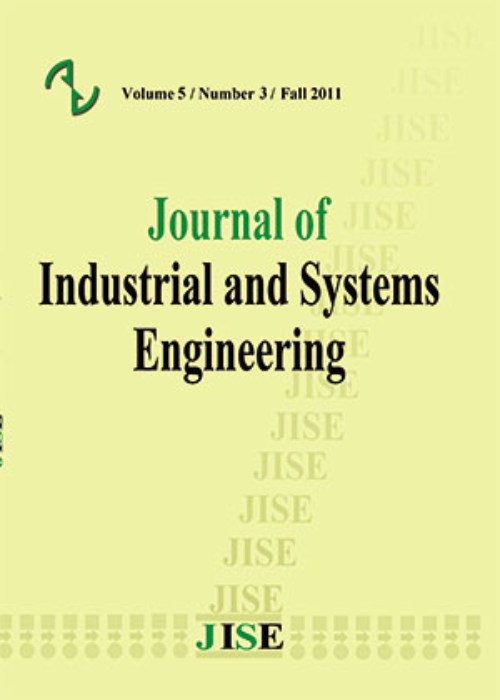فهرست مطالب
Journal of Industrial and Systems Engineering
Volume:3 Issue: 2, Summer 2009
- تاریخ انتشار: 1388/06/11
- تعداد عناوین: 6
-
-
Page 72In this paper a two-dimensional non-oriented guillotine bin packing problem is studied when items have different priorities. Our objective is to maximize the total profit which is total revenues minus costs of used bins and wasted area. A genetic algorithm is developed to solve this problem where a new coding scheme is introduced. To evaluate the performance of the proposed GA, first an upper bound is presented. Then, a series of computational experiments are conducted to evaluate the quality of GA solutions comparing with upper bound values. From the computational analysis, it appears that the GA algorithm is able to give good solutions.
-
Page 85The present paper discusses the development of a Markov model for performance evaluation of coal handling unit of a thermal power plant using probabilistic approach. Coal handling unit ensures proper supply of coal for sound functioning of thermal Power Plant. In present paper, the coal handling unit consists of two subsystems with two possible states i.e. working and failed. Failure and repair rates of both subsystems are taken to be constant. After drawing transition diagram, differential equations have been generated. After that, steady state probabilities are determined. Besides, some decision matrices are also developed, which provide various performance levels for different combinations of failure and repair rates of all subsystems. Based upon various performance values obtained in decision matrices and plots of failure rates/ repair rates of various subsystems, performance of each subsystem is analyzed and then maintenance decisions are made for all subsystems. The developed model helps in comparative evaluation of alternative maintenance strategies.
-
Page 97This paper proposes a new integrative view of manufacturing cell formation and both inter-cell and intra-cell layout problems. Cells formation and their popular bi-directional linear layout are determined simultaneously through a Dynamic Programming algorithm (with the objective of minimizing the inter-cell flow cost under a cell size constraint). This Dynamic Programming lgorithm is implemented in a Simulated Annealing approach with Genetic operators to reach ear optimal solutions. Moreover, within this approach and by using an Ant Colony ptimization technique, we also solve the intra-cell layout problem,. e., we also determine how o lay out machines within relative cells. In contrast with most of he available approaches in he literature, we consider: (1) An integrated objective function to minimize overall inter-cell nd intra-cell flow costs instead of merely minimizing the number of inter-cell ovements/costs. (2) The integrative and simultaneous determination of cell formation and heir layout instead of using sequential approaches. (3) All three phases of cell formation, intercell nd intra-cell layout design problems, which are all important for overall performance of he system, and (4) An easy to code and solve integrated procedure through implementing etaheuristic approaches. Our computational results show that by incorporating intra-cell ecisions in cell formation and inter-cell design process through implementing our proposedintegrated approach, a manufacturer can largely reduce her total material flow cost. Particularly,our computational tests show good quality solutions in comparison with the most similaravailable approach in the literature with an average improvement of 24.97% in total flow costfor a set of randomly generated test problems.
-
Page 116This paper discusses the development of a new GA for layout design. The GA was alreadydesigned and reported. However the implementation used in the earlier work was rudimentary and cumbersome, having no suitable Graphical User Interface, GUI. This paper discusses the intricacies of the algorithm and the GA operators used in previous work. It also reports on implementation of a new GA operator which was not included in earlier reports. The software was then used to conduct a series of experimentations to establish the best configuration of the operators for better results. The paper is also demonstrating a comparison of the new GA results and results from the literature. In addition the results show the solution of two new problems by various methods from the author’s own layout developments in industry. The results demonstrate that in most cases the new GA is superior to the existing methods. In particular the speed of the new GA is achieving a reasonable solution is significantly low.
-
Page 125The allocation of risks among the contracting parties in a contract is an important decisionaffecting the project success. Some risks in a project are uncontrollable; these are imposed to a project by external factors. Since contracting parties can neither control nor affect the occurrence of such risks, their allocation to a party would be inequitable. Therefore the cost overrun related to uncontrollable risks should be shared between contracting parties with a ratio which makes a win-win relationship between them in contract. This paper presents a mathematical model to achieve an equitable cost sharing ratio for uncontrollable risks between an owner and a contractor before contract conclusion using multi attribute utility theory.
-
Page 140This paper deals with the performance analysis of the screening unit in a paper plant usingGenetic Algorithm. The screening unit in the paper plant has four main subsystems. Thesesubsystems are arranged in series and parallel configurations. Considering exponentialdistribution for the probable failures and repairs, the mathematical formulation of the problem is done by Markov birth-death process. Using probabilistic approach, the differential equations are developed. These equations are then solved using normalizing conditions to determine the steady state availability of the screening unit. The performance behavior of each subsystem of the screening unit has also been analyzed using Genetic Algorithm. So, the findings of the present paper will be highly useful to the plant management for the timely execution of proper maintenance decisions and hence to enhance the system performance.


